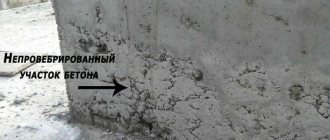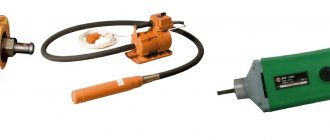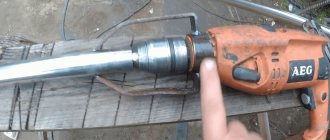From compressed air | 11/12/2016
As a simple but indispensable mechanical device, the wedge has been used for many years. When using this technique, it becomes possible, by applying a small force to press the wedge into a slot or hole, to create a large amount of force directed perpendicular to the direction of this movement. With the development of technology, hydraulics began to be used to move the wedge, which makes it possible to obtain more powerful forces. This device is called a hydrocline and is used quite widely today.
Hydrocline. Silent Destroyer
As a simple but indispensable mechanical device, the wedge has been used for many years. When using this technique, it becomes possible, by applying a small force to press the wedge into a slot or hole, to create a large amount of force directed perpendicular to the direction of this movement. With the development of technology, hydraulics began to be used to move the wedge, which makes it possible to obtain more powerful forces. This device is called a hydrocline and is used quite widely today.
Briefly about the main thing
Concrete can be destroyed in different ways. If you have enough strength and are not afraid of dirt and noise, a mechanical one using impact tools - a hammer drill, a sledgehammer, a jackhammer - will do. You can avoid concrete dust settling in all corners of the house by renting hydraulic equipment - a wedge or scissors. But the most effective and least labor-intensive technologies are considered to be “silent explosion”, when concrete bursts due to bursting loads created by frozen water, swollen wooden wedges, or an expanding chemical.
Source
Methods for destroying concrete
Since we are talking about fairly large objects, we will ignore the sledgehammer, grinder and hammer drill and focus on more productive and modern methods.
- When demolishing free-standing objects, the directed explosion method is used. Apart from lengthy preparation, calculations, and laying, then in a few seconds we get what we want - a pile of rubble instead of an unnecessary building. The method is effective, but unsafe and is not used in a densely populated city.
- Diamond installations, wall saws and rope cutters - allow you to dismantle any objects or their parts quickly, silently, in any conditions. The only BUT that can stop it is the cost of the work. It is not prohibitively high, but you always want to know about more budget-friendly options without compromising on quality.
- Using a hydrocline to destroy concrete is the most affordable method. It is based on the fact that concrete is the least tensile resistant.
Advantages of use
The advantages that a hydrocline has are many. In some applications, such as concrete demolition, there are virtually no alternatives to this device. Of course, you can use explosives or break off pieces of concrete manually with a sledgehammer or jackhammers. However, in this case, many accompanying effects appear, such as noise, flying fragments, etc. Here are the advantages inherent in using a hydraulic wedge when dismantling building structures:
- no need for complex preliminary calculations;
- Structurally, the hydrocline is quite simple, working with it is understandable to anyone;
- during operation there are no flying fragments, dust, or excess noise;
- destruction occurs quickly and efficiently;
- the design of the device ensures safe operation;
- the dismantling process is controllable;
- ease of transportation;
- low cost of work;
- long service life of the installation.
The hydraulic wedge eventually became one of the best removal devices. Thanks to this tool, the destruction of concrete or brick has become a virtually silent and accurate process.
Indication:
Treatment of poorly healing wounds in a humid environment.
The dressing is suitable for the treatment of chronic wounds of various origins and any location, with clinical signs of infection (trophic venous ulcers, diabetic ulcers, bedsores and other poorly healing wounds), when active cleansing of the wound and maintaining adequate conditions for its healing are required. In addition, it can be used to reactivate stagnant wound healing processes if they are caused by ultra-high activity of MMPs (matrix metalloproteases).
- carry out excavation of rocks in large volumes without the use of explosives;
- dismantle structures and structures made of concrete, withstanding high maximum loads;
- eliminate the scattering of fragments and extreme vibrations during the work;
- carry out work on silent excavation of horizontal and vertical tunnels;
- work for a long time without downtime due to the use of special lubricant.
For sale in Russia and the CIS, it offers two models of Yamamoto hydraulic wedges for rock destruction at a price from the manufacturer. The company's website presents models HRB-100 and HRB-1700.
The operation of all models of heavy-duty hydraulic wedges is based on the principle of using counter wedges that are inserted into the hole and split the rock. The force is realized through the operation of a hydraulic cylinder, which drives the central wedge between two counter wedges. As a result, the scattering of rock fragments is completely eliminated, and the level of vibration and noise is reduced to a minimum.
Russian companies in the field of construction, tunneling and mining have already appreciated the high efficiency of working with this hydraulic wedge, abandoning unsafe methods using explosives and impact hammers. At the same time, the Yamamoto Rock Splitter is characterized by high accuracy, which is not found in analogues. This is achieved through the ability to direct and determine the volume of rock splitting. Now, with the help of such a mounted tool, it is possible to excavate both vertical and horizontal workings. Japanese engineers took care of the compatibility of the hydraulic wedge with all types of domestic and foreign equipment.
LLC "BROCK SZ" 190068, St. Petersburg, emb. Kryukova Canal, 31, room. 1-N, lit. A INN 7839339534 OGRN 5067847185775
GENERAL PROVISIONS
The operating principle of a hydrocline (concrete breaker) is based on the low tensile strength characteristics of concrete and consists of a strong tensile effect on concrete from the inside, without dynamic loads. The thrust force created by the hydrocline reaches hundreds of tons, which causes concrete destruction. Hydrocline is mainly used for the destruction of large masses of concrete, dismantling foundations, concrete foundations, pedestals, walls and other work. Destruction of concrete and reinforced concrete with a hydrocline is effective where it is impossible to use heavy special equipment and carry out blasting operations. Dismantling with a hydraulic wedge is especially indispensable in cases where it is impossible to use a jackhammer or blasting operations due to the harmful effects of vibration on concrete structures and structures. This technology allows you to quietly dismantle concrete and reinforced concrete, without noise and dust.
The hydraulic wedge allows you to perform tasks such as:
– dismantling of reinforced concrete structures;
– destruction of concrete masses;
– dismantling reinforced concrete pads and pedestals;
– destruction of natural stone (marble, granite, rubble and others);
– dismantling of brick walls and masonry;
– destruction of boulders and rocks.
The main advantages of destruction with a hydrocline (concrete breaker).
When working with a hydrowedge, it is possible to control the dismantling process: destruction occurs in a certain direction without damaging nearby structures and structures.
Hydraulic equipment is portable and relatively lightweight, can be easily carried and transported by passenger vehicles, and can be used in confined spaces where it is impossible to fit heavy equipment.
When dismantling reinforced concrete, the hydrocline quite easily copes with the reinforcement in the concrete.
Hydraulically breaking concrete, reinforced concrete, brick and natural stone reduces the noise and vibration on a construction site that is present with traditional demolition methods. Which, in turn, allows dismantling work to be carried out in residential buildings without creating constant serious discomfort for residents. This technology is safer, since during the destruction process, fragments of material do not bounce off, which is dangerous for workers when working in a confined space (Fig. 1-2).
A hydrocline can replace blasting work in places where such work is impossible or is complicated by nearby buildings.
Fig.1-2. Destruction of concrete using a hydrocline (concrete breaker)
The standard destruction technique uses external loads when performing work, which causes the material to resist, that is, the quality of work noticeably deteriorates. The technology used by the hydrocline allows the expansion strength of concrete or stone to be used (Fig. 3).
Fig.3. The technology used by the hydrocline allows the expansion strength of concrete or stone to be used
During impact and blasting operations, it is necessary to frequently stop work and take measures to protect walls, nearby buildings and equipment. It takes time and costs money. With hydrowedge equipment, this is not necessary because there is no potential danger to the equipment and nearby people and objects.
Hydraulic wedging is controlled destruction. The destructive force is always under control. There is no danger of flying pieces, vibration or shock (Fig. 4).
There are no harmful side effects such as vibration and dust. You can also work in populated areas and inside buildings, because... no noise.
One of the main advantages of a hydrocline is undoubtedly its cost-effectiveness. For example, during blasting or impact work, it is often necessary to pause and create additional protection for nearby structures. This wastes time and wastes money. If you use a hydrocline, you not only do not need to stop work, but also additionally strengthen the structures. Safety for people and structures is a strong reason for using a hydrocline.
Access to the full version of this document is restricted
You can familiarize yourself with the document by ordering a free demonstration of the Codex and Tekhekspert systems.
Working with a hydraulic wedge
To install equipment in concrete masses, it is necessary to carry out diamond drilling of the trench. At this point, the hydrocline is inserted into the formed ditch with a diameter of 160 to 180 millimeters, subsequently activating the device using a pumping mechanism. During direct work, the concrete begins to experience strong tensile stress and high overload, leading the stone to destruction. Using a hydrocline, the destruction of the foundation will take place quickly and effectively.
The principle of the fundamental action of a hydrocline is quite simple. The force directed into any material contributes to the instant destruction of bricks, concrete or reinforced concrete. In essence, the process is identical to destruction with hydraulic shears. However, in this case, the wedges built into the device completely eliminate the possibility of the formation of various flying elements.
Hydraulic wedge set
The hydraulic concrete breaker includes three main and important components:
- Several hydraulic wedges.
- Hydro station.
- A set of hoses that differ in pressure levels, that is, low and high levels. These elements connect the hydraulic station with hydraulic wedges.
Depending on the model, hydraulic units may have a motor with a different structure installed. Consequently, equipment will be divided into types:
- Electric concrete breaker.
- Gasoline concrete breakers.
- Diesel devices.
- Air options.
The internal system pressure in the device is limited to 150 bar.
After looking at the hydrocline photo, the structure of the system becomes clear. The concrete breaker itself is made in the form of a metal container with retractable parts, that is, punches, and a flexible non-external chamber. At the moments when fluid is supplied to the hydraulic system, the chamber begins to actively expand, causing the punches and wedges to move.
And here you can read about a concrete joint cutter - interesting and useful information.
Where is it used?
The technique is most effective when working with a massive concrete base and in cases where controlled dismantling is carried out without the need for high precision breaking of the material. In particular, the method is used in the following cases:
- Dismantling of concrete columns and supports;
- Demolition of monolithic foundations;
- Dismantling of buildings and objects made of monolithic, reinforced concrete;
- Partial dismantling of objects for making openings.
When performing work, the thickness of the base and the strength of the concrete composition are not of great importance.
Hydraulic wedges
A hydraulic wedge is a hand-held dismantling tool that allows controlled splitting of material under the influence of hydraulic pressure. The most appropriate use of a hydrocline is where the use of standard dismantling methods is unacceptable due to dust, flying debris, vibration, noise and, in some cases, harmful exhaust.
A complete kit consists of one or more wedges, high and low pressure hoses and a hydraulic power unit.
Features of working with a hydrocline
When using a device for quarrying stone, drilling preliminary holes (holes) is carried out using drilling machines or hammer drills. Drilling in reinforced concrete structures must be done using diamond bits to ensure passage through metal reinforcement. Under conditions where dust formation is unacceptable, vacuum or water dust removal is used.
It is very important that the hole has sufficient depth while maintaining its straightness, as well as its exact diameter. A shallow hole depth can cause the wedge tip to break if it hits rock or concrete. Too large a hole diameter leads to a decrease in the spreading force. To achieve the required performance, the number of holes should be as small as possible for a specific task. This number can be determined experimentally. If for some reason the holes are not deep enough, you can try to work by raising the working tip to the appropriate height.
Before you start working with the hydraulic wedge, you need to apply lubricant to the working surfaces of the linings and the wedge itself. Only a properly lubricated wedge and pads make it possible to obtain maximum breaking force. Lack or insufficient lubrication reduces work efficiency and prevents maximum force from being achieved.
Device and principle of operation
The basis of the hydraulic wedge design is either the wedge itself, which is pushed between the linings using piston pressure, or a set of several small hydraulic cylinders that directly press the spacer bar from the inside. Fluid can be supplied to the working hydraulic cylinder (or several pistons) by a pump driven by various types of engines or manually.
At the preparatory stage, holes of the required diameter and depth are drilled in the material (or a cut is made if the device is used for felling timber). Then the working part of the tool is inserted into the prepared hole. Next, using hydraulics, pressure is created on the piston, which pushes the wedge between the linings. The linings themselves have a direct effect on the walls of the hole, crack or cut. The force reaches such values that not only help to drop the sawn trunk in the desired direction (used when felling wood), but also breaks stone or concrete from the inside, sometimes even breaking off steel reinforcement.
The most common hydrocline, mainly used for breaking concrete, consists of a cylinder, control equipment and the wedge itself with linings. The hydraulic cylinder body is made of steel and aluminum, which makes it not only reliable, durable, but also lightweight. The linings and the wedge itself are made of high quality steel with the addition of carbide elements. This makes it possible to withstand extremely high loads and increases the durability of the equipment.
When is concrete removal necessary?
Many people are aware of how to properly prepare concrete mortar and in what directions to use it. But if necessary, not everyone is informed about how to competently dismantle durable material. Do not forget that we are talking only about low-budget disposal options, the use of which will be relevant for small-volume structures. Workflows arise for various reasons, for example:
- redevelopment of residential premises;
- demolition of an unsuitable structure;
- partial recycling of the old foundation;
- dismantling of concrete pours.
Range of available products on the Russian market
You can buy Darda hydraulic wedges in various designs. The devices have a number of operational differences and deserve separate consideration.
Hydrocline C2S
Entry level equipment. The model is aimed at small spaces and is optimal for basic work.
- set of wedges – N
- weight – 18 kg
- actual splitting force – 195 t
- hole diameter – 32 mm
- hole depth – 270 mm
- wedge length – 140 mm
- degree of splitting – 9
Hydrocline C4S
Hydrocline for particularly precise operations. With its help, utility networks are laid and fragmentary destruction of structures is carried out.
- set of wedges – N
- weight – 22 kg
- actual splitting force – 230 t
- hole diameter – 34-36 mm
- hole depth – 430 mm
- wedge length – 250 mm
- degree of splitting – 10-10
Hydrocline C9
A universal model that solves standard and non-standard problems.
- set of wedges – N or L
- weight – 22, 23 kg
- actual splitting force – 200 t
- hole diameter – 45, 50 mm
- hole depth – 410.580 mm
- wedge length – 230, 400 mm
- degree of splitting – 18-44, 18-40
Hydrocline C12
A productive hand tool, in demand when destroying high-strength materials.
- Wedge set – N, L or W
- weight – 31.32 kg
- actual splitting force – 358, 413,321 t
- hole diameter – 45-48 mm
- hole depth – 610, 680, 550 mm
- wedge length – 380, 450, 340 mm
- degree of splitting – 20-50, 15-35, 24-56
When working with complex objects, it is advisable to use several wedges. This will speed up the production process and simplify non-standard operations.











